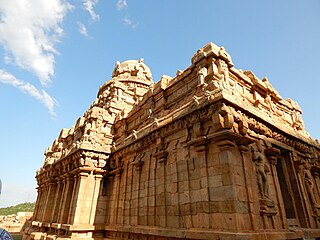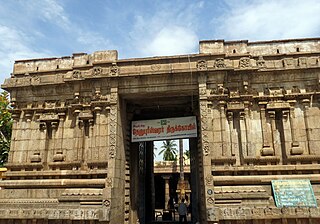
Rajaraja I, born Arunmozhi Varman or Arulmozhi Varman and often described as Raja Raja the Great or Raja Raja Chozhan was a Chola emperor who reigned from 985 CE to 1014 CE. He was the most powerful Tamil king in South India during his reign and is remembered for reinstating the Chola influence and ensuring its supremacy across the Indian Ocean.

The Great Living Chola Temples is a UNESCO World Heritage Site designation for a group of Chola dynasty era Hindu temples in the Indian state of Tamil Nadu. Completed between early 11th and the 12th century CE, the monuments include:

built by Tamil kings chola

Thirunandikkara Cave Temple, also referred to as Thirunanthikarai rock-cut Shiva temple, is a 9th-century rock-cut Hindu cave temple in Kanyakumari district, Tamil Nadu, India. It is dedicated to Shiva, with murals and inscriptions. It is attributed to the Ay king Vikramaditya Varaguna by Archaeological Survey of India, but to Pandya rulers (Nedunjadaiyan) a few decades earlier by Ajit Kumar, an archaeologist. It is part of a larger active temple complex named the Thirunanthikarai Shri Nandeeswara temple, Thirunanthikarai and is carved out of the side of a rocky hillock to the north of the temple complex. According to Rao, one of the inscriptions suggests that this may be a late 8th-century cave temple or early 9th.

Narthamalai, a cluster of small hills, is 25 km from Trichy on the Trichy-Pudukottai highway in the state of Tamil Nadu, India. Here can be seen some of the oldest rock cut cave temples, as well as the longest rock-cut edicts, similar to Asokan edicts and extremely rare in the south of India. The town houses Vijayalaya Choleeswaram built during the 9th century. The two rock-cut temples are classic examples of how temple architecture styles were fusing in different parts of the country.

Wadakkancherry is a major town in Thrissur, Kerala. Up until 1860, this area was part of Chelakkara Taluk. Now, it is the headquarters of Talappilly Taluk.

Brihadishvara Temple, officially called Rajarajeshwaram and known locally as Thanjai Periya Kovil and Peruvudaiyar Kovil, is a Shaivite Hindu temple built in a Chola architectural style located on the south bank of the Cauvery river in Thanjavur, Tamil Nadu, India. It is one of the largest Hindu temples and an exemplar of Tamil architecture. It is also called Dakshina Meru. Built by Chola emperor Rajaraja I between 1003 and 1010 CE, the temple is a part of the UNESCO World Heritage Site known as the "Great Living Chola Temples", along with the hola-era Gangaikonda Cholapuram temple and Airavatesvara temple, which are about 70 kilometres (43 mi) and 40 kilometres (25 mi) to its northeast respectively.

Mathilakam is a village in Kodungallur taluk, Thrissur district in Kerala, South India. It is located around 5 miles north of Kodungallur on National Highway 66.

Moovar Koil or "The Three temples" is a Hindu temple complex situated in the village of Kodumbalur, 36 kilometres from Pudukkottai in Tamil Nadu, India. These temples were constructed by the Chola feudatory and Irukkuvel chieftain Boothi Vikramakesari as per the inscription. Only two of the three temples have managed to survive. The place was ruled by Irukkuvel chieftains. Kodumbalur was also the site of a fierce battle between the Pandyas and the Pallavas.

Ramachandran Nagaswamy was an Indian historian, archaeologist and epigraphist who was known for his work on temple inscriptions and art history of Tamil Nadu. He was an authority on Chola bronzes.

The Ranganatha Swamy and the Someshwara temples are located in the historic town of Magadi, about 41 km from Bangalore, the capital of the Indian state of Karnataka. These temples are protected monuments under the Karnataka state division of the Archaeological Survey of India.
Chokkeeswarar Temple or Kousikeswarar temple is a Hindu temple located in Kancheepuram, Tamil Nadu, India. It is one of the protected monuments in Tamil Nadu declared by Archaeological Survey of India. The temple was built by Cholas in the 9th century CE.
Poondi Arugar Temple is a Jain temple which located 3 kilometres (1.9 mi) from Arani, Tiruvannamalai district, Tamil Nadu, India. The temple was built by Cholas. It is one of the protected monuments in Tamil Nadu declared by Archaeological Survey of India.

Dhenupureeswarar Temple, is located in Madambakkam near Tambaram, Chennai. Dhenupureeswarar is the local name for the Hindu deity Shiva.

The Arakeshvara Temple, dedicated to the Hindu god Shiva, is located in the village of Hole Alur in the Chamarajanagar district of Karnataka state, India. According to the historian Sarma, the temple which dates back to the middle of the 10th century rule of the Western Ganga Dynasty appears to have been renovated in later periods. It was constructed by King Butuga II around 949 A.D. to celebrate his victory over the Cholas of Tanjore in the historically important battle of Takkolam. It was a military engagement between crown prince Rajaditya, son of the Chola King Parantaka I, and King Butaga II. The temple is protected as a monument of national importance by the central Archaeological Survey of India.

Vijayalaya Choleeswaram in Narthamalai, a panchayat town in Pudukottai district in the South Indian state of Tamil Nadu, India, is a temple dedicated to the Hindu god Shiva. Constructed in the Dravida style and rock cut architecture, the temple is believed to have been built during the 9th century by Mutharaiyar dynasty kings, the cardinals of Pallavas, with later expansion from the Cholas. The rock-cut architecture is an early example of Cholan Art, continuing the tradition of the Pallavas. The other portions of Narthamalai houses the 8th century Jaina Abode, the Aluruttimalai Jain Caves. There are also two rock-cut caves, one of which houses twelve life size sculptures of Vishnu. The temple is considered one of the oldest stone temples in South India.

Kunnandarkoil Cave Temple in Kunnandarkoil, a village in Pudukottai district in the South Indian state of Tamil Nadu, is dedicated to the Hindu god Shiva. Constructed in Rock-cut architecture, the temple is believed to have been built during the 8th century by Muttaraiyar kings, the cardinals of Pallavas, with later expansion from the Vijayanagar Empire. The rock-cut architecture in the temple is a specimen of the late Pallava Art and an early example of Chola Art. The temple has various inscriptions from Cholas, Chalukyas, Pandyas and Vijayanagar Empire. The temple is considered one of the oldest stone temples in South India. The temple is maintained and administered by Department of Archaeological Survey of India as a protected monument.

Vadukeeswarar Temple is a Hindu temple dedicated to the deity Shiva, located in Thiruvandarkoil, a village in Pondicherry - Villupuram highway in Pondicherry in the South Indian state of Tamil Nadu. Shiva is worshiped as Vadukeeswarar, and is represented by the lingam. His consort Parvati is depicted as Thiripura Sundari. The temple is located on the Chennai - Villupuram highway. The presiding deity is revered in the 7th century Tamil Saiva canonical work, the Tevaram, written by Tamil saint poets known as the nayanmars and classified as Paadal Petra Sthalam.
Sri Someswara Swamy Temple is a temple to Shiva located in Appikonda, Visakhapatnam.

Parthasarathy Temple, also spelled Parthasarathi Temple, is a 9th-century Hindu temple dedicated to Vishnu in Kanyakumari district of Tamil Nadu, India. Spread over 2.5 acres, the temple is notable for the extensive records about it that have been discovered in Huzur Plates of Kollam. The inscriptions on these plates describe how the temple was built along with a salai for 95 students to study the Vedas and other subjects in the Taittiriya, Talavakara and Bhavishya sakhas.
















